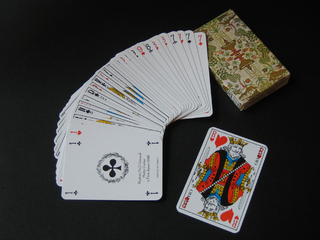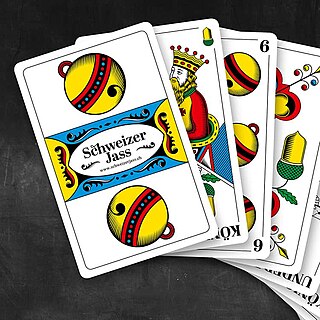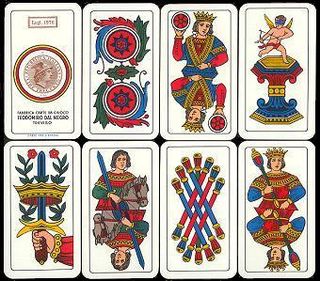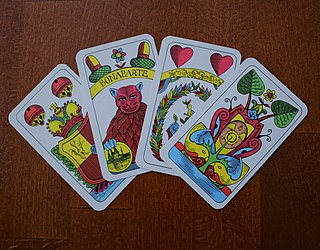
Piquet is an early 16th-century plain-trick card game for two players that became France's national game. David Parlett calls it a "classic game of relatively great antiquity... still one of the most skill-rewarding card games for two" but one which is now only played by "aficionados and connoisseurs."

Sixty-Six or 66, sometimes known as Paderbörnern, is a fast 5- or 6-card point-trick game of the marriage type for 2–4 players, played with 24 cards. It is an Ace-Ten game where Aces are high and Tens rank second. It has been described as "one of the best two-handers ever devised".

Jass is a family of trick taking, Ace-Ten card games and, in its key forms, a distinctive branch of the Marriage family. It is popular in its native Switzerland as well as the rest of the Alemannic German-speaking area of Europe, Italian South Tyrol and in a few places in Wisconsin and Ohio, USA.

Tressette or Tresette is a 40-card, trick-taking card game. It is one of Italy's major national card games, together with Scopa and Briscola. It is also popular in the regions that were once controlled by the Italian predecessor states, such as Albania, Montenegro, coastal Slovenia and coastal Croatia. It is also played in the Canton of Ticino with a French-suited deck. The Austrian game Trischettn as historically played in South Tyrol is also a derivative, albeit played with a 32-card German-suited deck.

Brisca is a popular Spanish card game played by two teams of two with a 40-card Spanish-suited pack or two teams of three using a 48-card pack.

Manille is a Catalan French trick-taking card game which uses a 32 card deck. It spread to the rest of France in the early 20th century, but was subsequently checked and reversed by the expansion of Belote. It is still popular in France and the western part of Belgium.

The following is a glossary of terms used in card games. Besides the terms listed here, there are thousands of common and uncommon slang terms. Terms in this glossary should not be game-specific, but apply to a wide range of card games. For glossaries that relate primarily to one game or family of similar games, see Game-specific glossaries.

Bohemian Schneider is a card game for two people, which is played with a German-suited Skat pack of 32 cards. Because it is a simple trick-taking game, it is often played by older children and is recommended for age 8 upwards. It was probably developed in Bohemia and spread from there across the south German region and Austria. The game is sometimes called Bohemian Tailor, Schneider being German for "tailor".
Russian Schnapsen, Thousand Schnapsen, 1000 or Tysiacha is a trick-taking game of the Ace-Ten family for three players, the aim of which is to score over 1000 points to win the game. It is a variant of the popular Austrian game of Schnapsen. Like its parent, Russian Schnapsen features "marriages" which are worth extra points.

Bauerntarock also called Brixentaler Bauerntarock or Brixental Tarock, is a point-trick card game played in the Brixental, Austria. It may have originated in the 19th century either as an adaptation of 54-card Tapp Tarock onto the cheaper and smaller 36-card German pack. Another possibility is that it was adapted from the 78-card Grosstarock or Taroc l'Hombre game as the ratio of trumps to non-trumps is almost the same. It uses the Skat Schedule found in popular regional games such as Jass and Schafkopf. It is closely related to Bavarian Tarock, German Tarok, Württemberg Tarock and especially Dobbm. Like Bavarian Tarock and Tapp, Brixental Bauerntarock and Dobbm do not belong to the true tarot games, but have adopted rules from Tapp Tarock. The most fundamental difference between these games and true tarot games is in the use of German or French decks instead of true Tarot playing cards.

The card game of Bauernschnapsen is an expanded form of the popular Austrian card game of Schnapsen, played by four players. This variant of Schnapsen is played throughout the whole of Austria.

Dobbm or Tappen is a card game played in the Stubai valley in Austria and is one of a family of games derived from the Tarot game of Grosstarock by adapting its rules to a regular, shortened pack of 36 cards. The ranking and point value of the cards in Dobbm is typical of the family and, like its other members, one player always plays as a soloist against all the others. It is highly popular in the Stubai valley among card players of all generations, but is unknown in the surrounding regions.

Dreierschnapsen, Talonschnapsen or Staperlschnapsen is a three-hand variant of the popular Austrian card game, Bauernschnapsen. The rules are very similar to those for Bauernschnapsen except that, instead of two teams of two players, one player bids to become the soloist against the other two who form a temporary alliance. Another difference is that the game makes use of a talon with which the soloist may exchange cards to improve his hand, hence its alternative name of Talonschnapsen. The game is usually played with William Tell cards.

Droggn, sometimes called French Tarock is an extinct card game of the Tarock family for three players that was played in the Stubai valley in Tyrol, Austria until the 1980s. Droggn is originally local dialect for "to play Tarock", but it has become the proper name of this specific Tarock variant. An unusual feature of the game compared with other Tarock games is the use of a 66-card deck and that, until recently, there was no record in the literature of a 66-card game and no current manufacturers of such a deck. The structure of the game strongly indicates that it is descended from the later version of Tarok l'Hombre, a 78-card Tarock game popular in 19th-century Austria and Germany, but with the subsequent addition of two higher bids.

Blattla is a Bavarian card game for four players, who usually form two teams of two for each deal. It is a simplified version of Schafkopf and Bierkopf and is thus a point-trick game. Unlike those two games, in Blattla the Obers and Unters are not permanent trumps. In order to learn the rules of Schafkopf, it can be an advantage to first become familiar with Blattla. The game is traditionally played with Bavarian pattern cards.

Solo 66 is a trick-taking, Ace-Ten, card game for five players in which a soloist always plays against the other four. It is based on the rules of Germany's national game, Skat, and is played with a French-suited Skat pack of 32 cards. Bidding is for the trump suit. Jacks are ranked within their respective suits and do not form additional trumps over and above the cards of the trump suit. Grupp describes it as "an entertaining game for a larger group."

Rumpel is a card game, that is native to the Danube region from Regensburg to Linz, but is played especially in the region of Hauzenberg in the German county of Passau. Mala describes a version with 8 or 12 contracts from a menu of 29 called Großer Rumpel. It is a descendant of the old Austrian student's game of Quodlibet.

Rosbiratschka is a trick-taking, compendium, card game for three or four players that is played with a German-suited pack of 32 or 24 cards.

Jaggln or Jaggeln is an historical Tyrolean card game designed for five players that used to be played purely as a winter pastime by farming folk. An unusual feature are its three highest trumps known as Jaggl, Zanggl and Buggl. The aim is to win the majority of Gewisses – i.e. the four Sows, the four Tens and the Jaggl. So, for example, if a player holds all three top trumps, he is certain to win 3 tricks. And if, in doing so, he captures the four Sows, he has won because he has five of the nine Gewisses.
Herzblatt or Herzblättchen is a German card game of the Ace-Ten family for two to five players. It bears a certain resemblance to the extinct 19th-century game of Piquesept, however without the special rules associated with the trump Seven.














